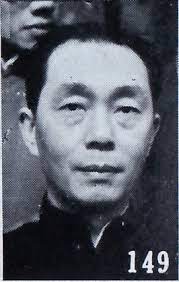Hsiao T'ung-tzu (1894-), director of the Central News Agency from 1932 to 1950. Ch'angning, Hunan, was the birthplace of Hsiao T'ung-tzu. Little is known of his early life. He was graduated from Hunan Industrial College in Changsha in 1917. His first known activities were in connection with the Hunan labor movement in the winter of 1920. At that time, Hsiao was associated with Huang Ai and P'ang Jen-ch'uan, who were shot in January 1921 in connection with the strike at the Hua-shih Cotton Mill in Changsha. Hsiao was not a labor organizer; he appears to have restricted his activities to such propaganda work as the preparation of posters and handbills. - Nevertheless, he was forced to flee Changsha in 1921.
Hsiao went to Canton and became associated with the Kuomintang. He reportedly prepared propaganda for the Northern Expedition. After the National Government was established at Nanking in 1928, he became a secretary attached to the Kuomintang's central propaganda apparatus. In 1932 Hsiao T'ung-tzu was named director of the Central News Agency (Chung-yang t'ung-hsün she), which had been established at Canton in April 1924 as a subsidiary of the central propaganda department of the Kuomintang. Before Hsiao became its director, there was no long-term planning with regard to the operations of the agency except for the vague stipulation that Kuomintang branches and members should furnish news to the central party apparatus. For domestic news, the private Kuo-wen News Service of the Ta Kung Pao and the Shun-shih News Service in Shanghai were the leading news sources. Foreign news services dominated the dissemination of international news in China. Hsiao expanded and developed the Central News Agency into a respected news service. He realized at the outset that the agency, to be effective, had to achieve a more independent status. Hsiao's first step was to move the Central News Agency office out of the Kuomintang headquarters building at Nanking. Although he continued to receive party directives, he was given a free hand in establishing a news collection and distribution service. Hsiao opened branch offices in all the important cities of China, organized a wire service with its own telegraphic facilities, and arranged for the exchange of news with foreign news agencies operating in China.
By 1937 the Central News Agency had 10 bureaus and 21 staff correspondents. A total of 159 Chinese newspapers subscribed to the service, which handled 15,000 words of incoming news and 20,000 words of outgoing news daily. The success of the Central News Agency forced the Kuo-wen News Service to close. In 1936, when Sino-Japanese relations were entering a crucial stage, Hsiao recruited Ch'en Po-sheng, a veteran journalist who was known as a Japan specialist, to open a Tokyo bureau, the first overseas branch of the Central News Agency. The same year, Feng Yü-chen, the chief reporter of the agency, was sent to Berlin to cover the Olympic Games. After the Sino-Japanese war broke out, the Central News Agency was forced to close its bureaus in areas of China occupied by the Japanese. Hsiao moved his headquarters to Chungking. Despite the difficulties of wartime operation, he maintained 18 domestic news bureaus in China and a staff of field correspondents. A new photographic department was established to provide pictorial coverage of the war. When Japanese bombing of Chungking was heavy, the central staff worked underground in deep dugouts. By this time the principal foreign news agencies, notably Reuters and the United Press, had concluded arrangements with the Central News Agency by which their dispatches were issued under a joint dateline with the Central News Agency. This development reflected the growth of the agency's English-language department, which served the foreign press. The first Central News Agency office outside the Far East was established at Washington in 1940; within five years bureaus had been opened in New York, London, Moscow, New Delhi, Calcutta, and Paris. The agency's reporters were attached as war correspondents to major commands in the Pacific theater.
At Chungking, Hsiao was elected president of the Chinese National Press Association. He worked closely with Hollington Tong (Tung Hsien-kuang, q.v.), who handled relations with the foreign press corps and distributed official news. After 1938 Ch'en Po-sheng served as chief editor of the Central News Agency and handled much of the technical work of the enterprise.
Hsiao served as director of the Central News Agency until 1950. He then relinquished his post to Tseng Hsü-pai, but remained chairman of the supervisory board. In 1954 he became an adviser to Chiang Kai-shek in Taipei. Hsiao was never regarded as being active in party affairs; however, he was a member of the Central Executive Committee of the Kuomintang after 1934.

萧同兹
萧同兹(1894—),1932—1950年任中央通讯社社长。
萧同兹的出生地是湖南常宁,他幼年时情况不详。1917年毕业于长沙湖南工业学校。1920年,他最先为人所知的活动是参加了湖南工人运动。那时他和黄爱、庞人铨共事,这两个人因与长沙华实棉纺厂的罢工有关,1921年1月被枪决。萧同兹不是劳工组织者,他只做一些宣传工作,如贴标语散传单之类。尽管如此,他也不得不在1921年逃离长沙。
萧同兹到广州后和国民党发生联系。他为北伐作宣传工作。1928年,国民政府在南京成立后,他在国民党宣传机构中当了一名秘书。
1932年,萧同兹任中央通讯社社长,该社是1924年4月在广州就成立的,原是国民党中央宣传部的一个附属机构。萧任社长之前,该社并无长远工作计划,不过泛泛规定国民党各分支部和党员应向中央宣传机构提供新闻报道。国内消息,以私营的大公报国闻通讯社和上海申时通讯社为主要来源,国外新闻的散发则由在华的各国通讯社所控制。
萧同兹把中央通讯社办成了一个有地位的通讯社,他一开始就认识到,要使通讯社的工作有效率就必须取得比较独立的地位。第一步,他把中央通讯社搬出南京中央党部大楼。虽然仍由国民党监管,但他可以放手建立一个采访和发送新闻的机构。他又在全国各重要城市设立分社,以自备的电讯设备建立一个电讯网,并和在华的外国通讯社交换消息。
到1937年,中央通讯社已有十个局,二十二个通讯员,全国有一百五十九家报纸向该社订购消息,每日收进一万五千字和发出二万字的新闻。中央通讯社的成功,使国闻通讯社不得不停办。1936年中日关系危急,他聘请新闻界老手日本问题专家陈博生主持日本分社,这是中央讯社第一个国外分社。同年,主要通讯员冯有真去柏林报道奥运会消息。
中日战争爆发后,日本占领区内的中央通讯社全部被迫封闭。萧同兹把总社迁往重庆,战时进行工作虽很困难,但仍有十八个分社和一批战地记者,后来又设立了摄影部提供有关战事的图片。日本狂炸重庆时,中央通讯社人员在地下室工作。当时的主要外国通讯机构如路透社、合众社已与中央通讯社有协定,联合发布新闻。这一发展反映了该社英语部扩大向国外报社发稿。中央社在远东以外的第一个分社于1940年设在华盛顿。五年之中,又在纽约、伦敦、莫斯科、新德里、加尔各答设立分社。新闻记者同时充当太平洋战区各主要司令部的战地通讯员。
萧在重庆被选为全国新闻联合会主席。他和董显光密切合作。董显光负责接待外国记者团,发表官方消息。1938年,陈博生任中央通讯社总编辑,负责该社许多技术上的工作。
萧同兹任中央通讯社社长一直到1950年,后由曾虚白继任,但萧仍任监事会主任。1954年他在台北当蒋介石的顾问。从来没有人把萧同兹视为国民党党务活动分子,但从1934年以来他就是国民党的中央执行委员。